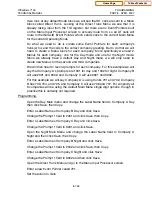
OfficeServ 7100
PROGRAMMING
TECHNICAL MANUAL
PART 8 APRIL 2007
8.1.25
Enter an extension number in the upper right text box and click Call and answer
the extension when it rings.
Change the language drop down on the Prompt Recording Studio screen from
English to Spanish.
Locate prompt No. 1001 and click it.
Follow the Spanish prompt instructions to record and save the Spanish menu
prompt.
Open the Prompt screen.
Locate prompt No. 1001 and click it.
Follow the English prompt instructions to record and save the English menu
prompt.
Open the Prompt screen.
Locate prompt No. 1010 and click it.
Follow the English prompt instructions to record and save the "Thank you for
calling XYZ Company, press 2 for Spanish or hold for English" prompt.
Test the application by making a test call to the automated attendant and
verifying the multilingual functions.
8.1.8.11 Multiple Company Greetings Based on Trunk
Scenario:
A customer site has 3 companies utilizing the same system. They would like to
have each company's trunks answered with a specialized automated attendant
company greeting rather than all callers hearing one generic greeting. They
have also requested that each company be allowed a different day and night
greeting.
Planning:
Since each company has their own trunk or trunks, we know that that will be the
identifying tag to let the automated attendant know which company is calling.
But how do we get the automated attendant to look for a specific trunk and take
action?
If we look at the System Registers we see a register called TID. This register will
hold the trunk number the caller is connected on. So we need to know how to
route off that Register. To do that we must look at the flow of a call in this
scenario. All trunks are set to ring directly to the automated attendant. According
to the Call Code standard that means this is a Direct Trunk (DT) call type.
Home Page
Table of Contents
























